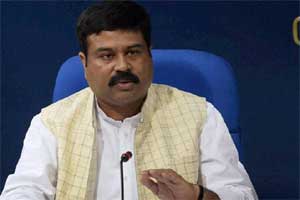Prime Minister Narendra Modi may be a big proponent of gas grids and oil minister Dharmendra Pradhan may talk of how natural gas will replace other fuels, but the government’s ambitious pipeline projects remain stuck — not only is the existing capacity underutilised at just around 40% usage thanks to poor availability of natural gas (see graphic), even new projects are flailing. Two years after finance minister Arun Jaitley proposed to lay 15,000 km of new natural gas pipelines, the government has still to finalise a plan on how these are to be financed.
While the petroleum ministry put up a proposal to fund the national gas grid through viability-gap funding (VGF), the finance ministry has turned this down. “In the evaluation of the gas pipeline project under viability gap funding scheme, the department of economic affairs opined that such scheme does not cover the funding for the development of gas pipelines,” a senior petroleum ministry official told FE. Though the ministry is looking at a direct funding, the finance ministry is yet to take a call on this.
Around 2,500 km of pipelines are to be set up under the public-private partnership-VGF model.
Following Jaitley’s Budget announcement, the petroleum ministry identified a 520-km pipeline — Bokaro-Ranchi-Angul — to be developed as a pilot PPP through VGF. The two other pipelines proposed under the same model are Barauni-Guwahati-Agartala and Haldia-Paradip-Srikakulam.
The petroleum ministry is now examining how the Bokaro-Ranchi-Angul section — part of the Jagdishpur-Haldia pipeline project of GAIL — can be funded. “The ministry has forwarded a proposal from GAIL to the finance ministry to consider the required funding of Rs 3,200 crore for implementation of first phase of Jagdishpur-Haldia pipeline,” said the official.
The primary reason for the lukewarm response to laying of gas pipelines is that there is no certainty on availability and the domestic market is not conducive to absorbing expensive imported gas. In such a situation, where creating the supply network is expected to create its own demand, a government grant is critical.
In the VGF model, a one-time grant is provided to projects that are economically justified but fall short of financial viability.
Infrastructure projects have long gestation periods and, in most cases, are not financially viable on their own.
In order to remove this shortcoming and to bring in private sector efficiencies, the government is promoting envisaging projects through ‘viability gap funding’. Primarily, this facility is meant to reduce capital cost of projects by credit enhancement and to make them viable and attractive for private investment through supplementary grant funding.
India’s largest gas transmission and marketing company GAIL’s 11,500 km of pipeline network is currently operating at below half its capacity.

